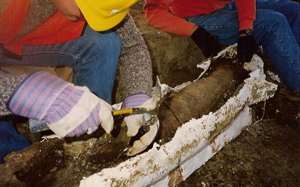 Transportation Corridor Agencies (TCA), Foothill Transportation Corridor (SR 241) and the San Joaquin Hills Transportation Corridor (SR 73), Orange County, CA
Transportation Corridor Agencies (TCA), Foothill Transportation Corridor (SR 241) and the San Joaquin Hills Transportation Corridor (SR 73), Orange County, CA
The Foothill Transportation Corridor (SR 241) runs along the edge of the Santa Ana Mountains connecting southern Orange County with the inland Empire. JMA conducted paleontological assessments and mitigation along the entire segment of the toll road including: archival research, pre-construction surveys, pre-construction salvage, and construction mitigation monitoring and salvage. A number of significant fossil localities from the Topanga and Oso members of the Capistrano Formations were identified during the course of the project. The fossil specimens collected include numerous marine and non-marine vertebrates such as a nearly complete walrus, sharks, seals, sea lions, dolphin, horse, and camel. Our laboratory staff prepared and curated fossils collected during monitoring.
Our staff also completed mitigation and documentation reports, including monthly and yearly progress reports and final reports. JMA developed mitigation monitoring measures through a Mitigation Monitoring Implementation Plan (MMIP) with definable, measurable implementation and compliance milestones and goals. JMA played a role in developing and finalizing the EIR for this controversial project.
The San Joaquin Transportation Corridor (SR 73) runs from Costa Mesa to San Juan Capistrano. JMA performed the project management and coordination of cultural and paleontological mitigation and monitoring services. Our staff conducted pre-construction paleontological surveys, pre-construction salvages, and prepared and curated fossils collected during field monitoring. JMA produced mitigation and documentation reports, including monthly, yearly progress reports, final reports and mitigation quarrying operations for the 18-mile toll road. JMA developed mitigation monitoring measures through a Mitigation Monitoring Implementation Plan (MMIP) with definable measurable implementation and compliance milestones and goals
During the course of the project JMA field monitors identified numerous and significant fossil localities and collected fossil vertebrate and invertebrate specimens from the Verdes and Capistrano Formations as well as unnamed Pleistocene terrace and fluvial deposits. The fossil specimens collected and identified consisted of Pleistocene nonmarine vertebrates including bison, horse, camel, and sloth.
The paleontological mitigations and management conducted by JMA during the course of the TCA projects have significantly contributed to the paleontological record in Orange County.